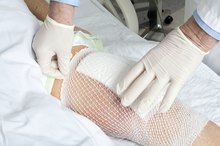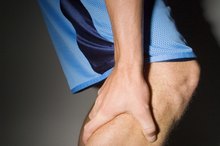Complications of ORIF Ankle Surgery
The abbreviation; O.R.I.F. stands for Open Reduction/Internal Fixation. This refers to a variety of open orthopedic surgical techniques where broken bones in the ankle are repaired using various devices to restore the bones to normal position and alignment, thus optimizing healing. The devices commonly used include metallic screws, pins and plates. As good as surgical techniques and fixations are these days, ankle fractures, together with open reduction and internal fixation, can have complications from the use of the fixation devices and from the injury itself.
If you are experiencing serious medical symptoms, seek emergency treatment immediately.
Infection
Microorganisms, typically colonized on the fixation devices themselves, such as:
- plates
- screws
- pins
- combine with the formation of a membranous bio-film that can resist antibiotic penetration to create considerable difficulty in treating the infection
Painful Retained Hardware
A Splint for a Humerus Fracture
Learn More
Another potential complication of ankle fracture surgery is the development of painful retained hardware. Because there is little subcutaneous fat between the skin and various bony prominences of the ankle, fixation devices such as screws and plates inserted in these areas can become uncomfortable as they can protrude under the skin and become sensitive pressure areas. One of the most common areas for this problem to occur is along the lateral, or outer, portion of the ankle called the lateral malleolus, which is made up of the distal, or end, portion of the fibula. Fixation devices easily protrude under the skin and can rub against shoes and boots, causing pain.
An article published in the "Journal of the American Academy of Orthopedic Surgeons" concluded that fixation removal merely for pain relief is not always a guaranteed symptom eradicator 1. The study evaluated thirty-nine patients, twenty-two of whom had hardware removal for pain symptoms. Only 50 percent had relief, concluding that hardware removal should not be performed merely for pain relief, and that careful consideration should be made as to expected outcomes before undergoing the procedure.
- Another potential complication of ankle fracture surgery is the development of painful retained hardware.
- Only 50 percent had relief, concluding that hardware removal should not be performed merely for pain relief, and that careful consideration should be made as to expected outcomes before undergoing the procedure.
Non-Union/Failure to Heal
Any open reduction/internal fixation procedure, not just in the ankle, carries a statistical risk of developing a condition known as a non-union. A non-union develops when the opposing edges of a fracture fail to heal. This typically occurs from the situation where the edges of the fracture fragments are too far apart to heal properly, or there is too much micro-motion occurring at the fixation site to prevent solid healing. The resultant disruption in blood supply can cause the bone edges to not heal or to form a soft fibrous attachment instead of solid bone formation.
- Any open reduction/internal fixation procedure, not just in the ankle, carries a statistical risk of developing a condition known as a non-union.
- This typically occurs from the situation where the edges of the fracture fragments are too far apart to heal properly, or there is too much micro-motion occurring at the fixation site to prevent solid healing.
Post Traumatic Arthritis
What Are the Symptoms of a Failing Knee Replacement?
Learn More
When an ankle fracture involves joint surfaces, the risk of developing degenerative arthritis is greatly elevated. According to a May 2007 article in the "Journal of Orthopedic and Sports Physical Therapy," post traumatic arthritis is the most common form of arthritis to affect the ankle.
Post-traumatic arthritis develops when the normally-smooth joint surfaces become damaged and irregular. When fixing an ankle fracture that has disrupted joint surfaces, it is critical that these surfaces be restored to as normal as humanly possible to minimize arthritis development.
- When an ankle fracture involves joint surfaces, the risk of developing degenerative arthritis is greatly elevated.
Related Articles
References
- Journal of the American Academy of Orthopedic Surgeons: Hardware Removal: Indications and Expectations
- M.D. Guidelines: Malunion and Nonunion of Fracture
- Bible JE, Mir HR. External Fixation: Principles and Applications. J Am Acad Orthop Surg. 2015;23(11):683-690. doi:10.5435/JAAOS-D-14-00281
- Hadeed A, Werntz RL, Varacallo M. External Fixation Principles and Overview. In: StatPearls. Treasure Island, FL: StatPearls Publishing; 2019.
- Salcedo Cánovas C. Bone elongation using monolateral external fixation: a practical guide. Strategies Trauma Limb Reconstr. 2015;10(3):175-188. doi:10.1007/s11751-015-0236-0
- Carmichael K, Torres D, Jimenez CJ, Comley MC, Evans EB. Spanning External Fixation for the Treatment of Open Joint Injuries in Pediatric Burn Patients. Cureus. 2018;10(4):e2484. doi:10.7759/cureus.2484
- De Bastiani G, Apley AG, Goldberg AAJ, eds. Orthofix External Fixation in Trauma and Orthopaedics. 1st ed. London: Springer; 2000.
- American Academy of Orthopaedic Surgeons. Ankle fractures (broken ankle). March 2013
- Clements JR, Motley TA, Garrett A, Carpenter BB. Nonoperative treatment of bimalleolar equivalent ankle fractures: a retrospective review of 51 patients. J Foot Ankle Surg. 2008;47(1):40-5. doi:10.1053/j.jfas.2007.10.005
- Xing W, Wang Y, Sun L, et al. Ankle joint dislocation treating dislocated trimalleolar fractures accompanied with the complex posterior malleolus fracture without separation of the tibiofibular syndesmosis. Medicine (Baltimore). 2018;97(37):e12079. doi:10.1097/MD.0000000000012079
- Lampridis V, Gougoulias N, Sakellariou A. Stability in ankle fractures: Diagnosis and treatment. EFORT Open Rev. 2018;3(5):294-303. doi:10.1302/2058-5241.3.170057
- Anderson RB, Hunt KJ, McCormick JJ. "Management of common sports-related injuries about the foot and ankle" J Am Acad Orthop Surg. 2010 Sep;18(9):546-56.
Resources
Writer Bio
Ken Chisholm is a freelance writer who began writing in 2007 for LIVESTRONG.COM. He has experience in health care, surgery, nursing and orthopedics as an orthopedic physician assistant and a registered nurse. He holds a bachelor's degree in business from the University of Findlay, Ohio.









